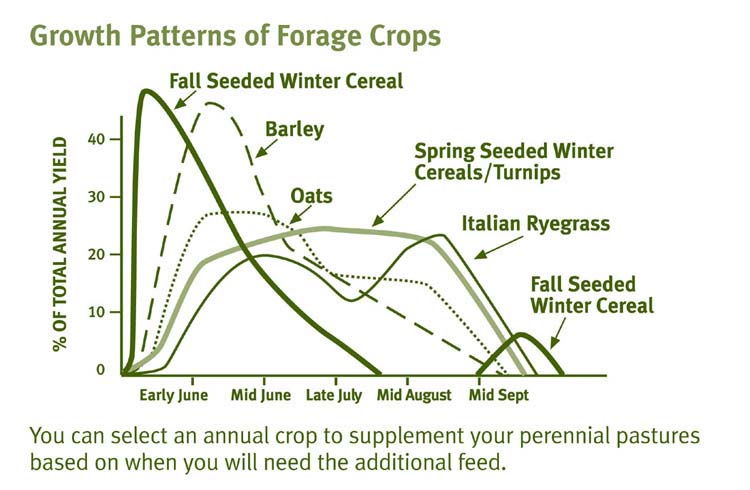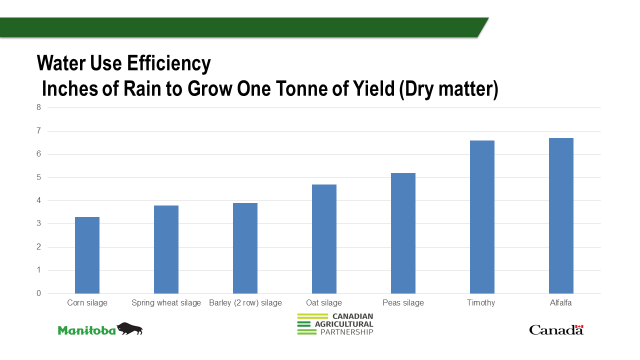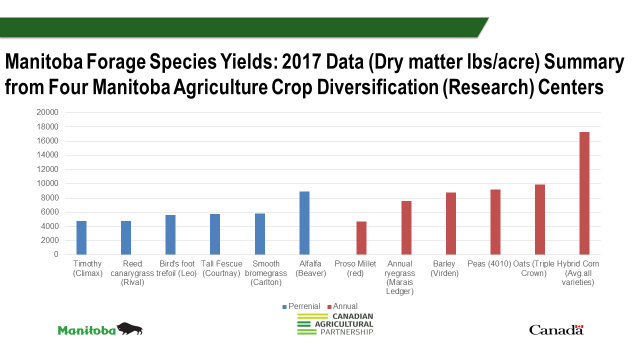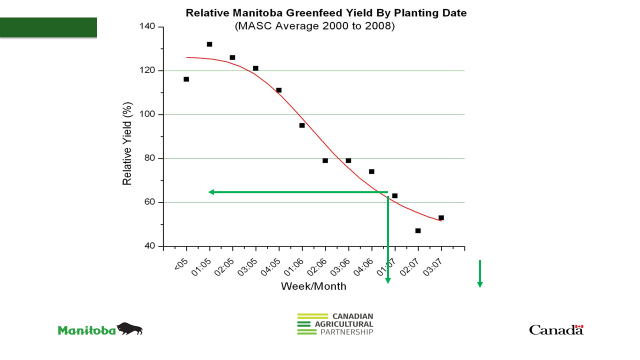Annual Crops: an Excellent Way to Increase Your Feeding Flexibility
Supplement Perennials With Annuals
Annual crops can provide for rest and recovery of perennial pastures from grazing or crop stress. They can be used to provide additional feed in years when you need it, such as during or after a drought, or they can become a routine part of your feeding strategy to give you added feeding flexibility. As part of your annual pasture rotation plan, annuals allow you to utilize more of your farm for grazing.
Because an annual crop can be grazed four to six weeks after spring seeding, and fall-seeded winter cereals can be grazed as early as mid-May, you can consider your selection of annuals based on when you need them (see growth chart below). Remember, for every day you delay grazing of your perennial pastures in the spring, you can gain three additional grazing days in the fall. Even if seeding is delayed, you can begin the grazing season on a perennial pasture, and move to an annual pasture when it’s ready. The perennial pasture will still profit from the rest.
Annuals cut for greenfeed can provide better quality feed than perennial hay. Higher protein levels are achieved when cut at soft dough stage; higher yields occur when cut at hard dough stage. Annual cereals are also an excellent source of silage. Not only will annuals help you get maximum returns from your perennial pastures, they can help you extend your grazing season – either in early spring or in late fall.


Crop Selection
Annual crops are 20-50% more water use efficient than perennial crops. Warm season crops are more water and fertilizer use efficient than cool season crops. Warm season annual crops include: corn, millet, sorghum, sorghum-sudan hybrids.

Crops for Grazing
Annual crops can be grazed and then cut for greenfeed or silage, or vice versa depending on livestock forage requirements and growth habit of plant species. Be careful to not cut or graze below the growing point of the plant or a significant yield penality will occur.
Crops for Greenfeed or Silage

Nitrate Levels
Annual crops can accumulate nitrates more than perennial crops – especially if they have received high levels of nitrogen fertilizer or are stressed due to drought or cold temperatures. If nitrate levels are high enough, animals can suffer from nitrite poisoning, so it’s important to test your crop before allowing animals to graze or before cutting it for green feed. Stored feeds can be tested for nitrates when samples sent into a feed test lab for analysis for feed quality. Manitoba Agriculture and Resource Development Service Centres have feed test sample bags and instructions available.
Avoid grazing or cutting the crop during and shortly after high stress periods — for example, immediately after a rainfall if it has been dry for a few consecutive weeks. This delay in harvesting will allow the accumulation of nitrates to dissipate as crop growth resumes. If you have cut a crop for green feed but you’re concerned about nitrates, ensiling it is a good way to reduce them.
Early Seeding Results in Higher Yield

Polycrops or Crop Mixes
Often mixtures of crops are seeded together to better utilize the soil and weather to produce higher yields or better quality of feed. Additionally mixes can extend the grazing season post harvest, and may provide some long lasting soil health benefits. Adding turnips, radish, annual ryegrass or sweet clover to forage mixes of barley/oats, barley/peas or oats/peas can extend the grazing season into the fall while providing ground cover to prevent wind and water erosion. This also helps to cool the soil to reduce evapotranspiration.
Production Tips
Fertility
Annual crop fertility is just as important for grazing, green feed, and silage crops as it is for grain production. Fertilize spring and winter cereals according to soil fertility tests and target yields. A properly fertilized greenfeed or silage crop will not only yield more and produce higher quality feed, but will also be more drought, disease and pest resilient. This will maintain good fertility conditions throughout the growing season and reduce the risk of high levels of nitrate accumulation in the plant. Applications of phosphate, potassium, and sulfur may also be necessary; potassium is especially beneficial for overwintering of fall-seeded cereals.
Maturity
As the plant matures, yield and energy will increase until the dough stage. However, the plant also becomes more fibrous as it matures, with protein beginning to fall right after the boot stage. Higher yields can be maintained at the expense of protein, and vice-versa. But because protein is an inexpensive supplement if required, the most-often recommended harvest stage for green feed and silage crops is at or near the dough stage.

Managing Grazing
Just as perennial pastures benefit from rotational grazing, so can your annual pastures. Giving them a rest by grazing one week on, three weeks off, can maximize your yields (see below).

Courtesy of the Western Forage/Beef Development Group, based on research from G. Reimer and R. Gaudie, AAFRD
Yields increase significantly when grazing occurs one week out of the month, as opposed to every second week or every week.
For More Information
- Contact your nearest Manitoba Agriculture and Resource Development Service Center 1-833-206-0451
You Can Help Reduce Greenhouse Gas
Healthy pastures and riparian areas are better able to sequester carbon, and more-widely distributed manure reduces greenhouse gas emissions compared to manure packs. For more information on greenhouse gas, and how livestock producers can do their part to help reduce it, visit the following website.
This information is posted with permission. The following agencies worked collaboratively and provided funding support for this publication:
- Manitoba Agriculture and Resource Development
- Agriculture and Agri-Food Canada
- Manitoba Forage and Grassland Association
Partial funding for this publication was provided by the Greencover Canada Program, a five-year, $110-million Government of Canada initiative designed to help producers improve grassland-management practices, protect water quality, reduce greenhouse gas emissions, and enhance biodiversity and wildlife habitat.

